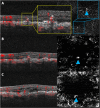Optical Coherence Tomography Angiography: A 2023 Focused Update on Age-Related Macular Degeneration
- PMID: 38180632
- PMCID: PMC10787708
- DOI: 10.1007/s40123-023-00870-2
Optical Coherence Tomography Angiography: A 2023 Focused Update on Age-Related Macular Degeneration
Abstract
Optical coherence tomography angiography (OCTA) has extensively enhanced our comprehension of eye microcirculation and of its associated diseases. In this narrative review, we explored the key concepts behind OCTA, as well as the most recent evidence in the pathophysiology of age-related macular degeneration (AMD) made possible by OCTA. These recommendations were updated since the publication in 2020, and are targeted for 2023. Importantly, as a future perspective in OCTA technology, we will discuss how artificial intelligence has been applied to OCTA, with a particular emphasis on its application to AMD study.
Keywords: 3D OCTA; Age-related macular degeneration; Artificial intelligence; Geographic atrophy; Non-exudative macular neovascularization; Optical coherence tomography angiography; Quiescent neovascularization; Subclinical neovascularization; Type 3 macular neovascularization.
© 2024. The Author(s).
Conflict of interest statement
Beatrice Tombolini, Emanuele Crincoli, Marco Battista, Federico Fantaguzzi, and Andrea Servillo have nothing to disclose. Riccardo Sacconi has the following disclosures: Abbvie, Bayer, Medivis, Novartis, Roche, and Zeiss. Francesco Bandello has the following disclosures: Allergan, Bayer, Boehringer-Ingelheim, Fidia Sooft, Hofmann La Roche, Novartis, Ntc Pharma, Sifi, Thrombogenics, and Zeiss. Giuseppe Querques has the following disclosures: Alimera Sciences, Allergan Inc, Amgen, Heidelberg, KBH, LEH Pharma, Lumithera, Novartis, Bayer Shering-Pharma, Sandoz, Sifi, Soof-Fidia, and Zeiss.
Figures



Similar articles
-
Practical guidance for imaging biomarkers in exudative age-related macular degeneration.Surv Ophthalmol. 2023 Jul-Aug;68(4):615-627. doi: 10.1016/j.survophthal.2023.02.004. Epub 2023 Feb 26. Surv Ophthalmol. 2023. PMID: 36854371 Review.
-
Exudative non-neovascular age-related macular degeneration.Graefes Arch Clin Exp Ophthalmol. 2021 May;259(5):1123-1134. doi: 10.1007/s00417-020-05021-y. Epub 2020 Nov 26. Graefes Arch Clin Exp Ophthalmol. 2021. PMID: 33242167
-
Optical coherence tomography angiography for detection of macular neovascularization associated with atrophy in age-related macular degeneration.Graefes Arch Clin Exp Ophthalmol. 2021 Feb;259(2):291-299. doi: 10.1007/s00417-020-04821-6. Epub 2020 Jul 3. Graefes Arch Clin Exp Ophthalmol. 2021. PMID: 32620993
-
Optical Coherence Tomography Angiography of Asymptomatic Neovascularization in Intermediate Age-Related Macular Degeneration.Ophthalmology. 2016 Jun;123(6):1309-19. doi: 10.1016/j.ophtha.2016.01.044. Epub 2016 Feb 12. Ophthalmology. 2016. PMID: 26876696 Free PMC article.
-
Optical Coherence Tomography Angiography of the Choriocapillaris in Age-Related Macular Degeneration.J Clin Med. 2021 Feb 13;10(4):751. doi: 10.3390/jcm10040751. J Clin Med. 2021. PMID: 33668537 Free PMC article. Review.
Cited by
-
Choriocapillaris Impairment, Visual Function, and Distance to Fovea in Aging and Age-Related Macular Degeneration: ALSTAR2 Baseline.Invest Ophthalmol Vis Sci. 2024 Jul 1;65(8):40. doi: 10.1167/iovs.65.8.40. Invest Ophthalmol Vis Sci. 2024. PMID: 39042400 Free PMC article.
-
The Relationship Between Aortic Stenosis and the Possibility of Subsequent Macular Diseases: A Nationwide Database Study.Diagnostics (Basel). 2025 Mar 18;15(6):760. doi: 10.3390/diagnostics15060760. Diagnostics (Basel). 2025. PMID: 40150102 Free PMC article.
-
Comparison of Retinal Microvascular Changes in Axial Spondyloarthritis Using Optical Coherence Tomography Angiography: Anti-TNF vs. NSAID Therapy.Diagnostics (Basel). 2025 Mar 1;15(5):597. doi: 10.3390/diagnostics15050597. Diagnostics (Basel). 2025. PMID: 40075844 Free PMC article.
-
OCTA: Essential or Gimmick?Ophthalmol Ther. 2024 Sep;13(9):2293-2302. doi: 10.1007/s40123-024-00985-0. Epub 2024 Jul 6. Ophthalmol Ther. 2024. PMID: 38970762 Free PMC article.
-
Dry age-related macular degeneration classification from optical coherence tomography images based on ensemble deep learning architecture.Front Med (Lausanne). 2024 Oct 9;11:1438768. doi: 10.3389/fmed.2024.1438768. eCollection 2024. Front Med (Lausanne). 2024. PMID: 39444813 Free PMC article.
References
-
- Borrelli E, Sadda SR, Uji A, Querques G. OCT angiography: guidelines for analysis and interpretation. In: OCT and Imaging in Central Nervous System Diseases: The Eye as a Window to the Brain: Second Edition. 2020.
Publication types
LinkOut - more resources
Full Text Sources

